Stephen Hong Sohn's Blog
July 2, 2025
A Review of Natasha Ngan’s Girls of Paper and Fire (Jimmy Patterson, 2018)
![[personal profile]](https://i.gr-assets.com/images/S/compressed.photo.goodreads.com/hostedimages/1491408111i/22407843.png) uttararangarajan
uttararangarajan
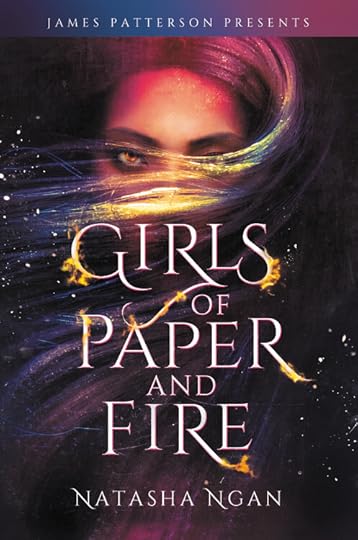
Written by Stephen Hong Sohn
Edited by Uttara Rangarajan
On the way home from a longer plane ride, I was worried about not being able to have enough to read, and I sort of didn’t want to start a new book in the middle of a flight, so I brought along a YA series. It ended up being a good idea, because I ended up finishing Natasha Ngan’s Girls of Paper and Fire (Jimmy Patterson, 2018) and getting through part of the second book in the series, which I will review as well. As per usual, let us allow the marketing description do some work for us: “In this richly developed fantasy, Lei is a member of the Paper caste, the lowest and most persecuted class of people in Ikhara. She lives in a remote village with her father, where the decade-old trauma of watching her mother snatched by royal guards for an unknown fate still haunts her. Now, the guards are back and this time it’s Lei they’re after: the girl with the golden eyes whose rumored beauty has piqued the king’s interest. Over weeks of training in the opulent but oppressive palace, Lei and eight other girls learns the skills and charm that befit a king’s consort. There, she does the unthinkable: she falls in love. Her forbidden romance becomes enmeshed with an explosive plot that threatens her world’s entire way of life. Lei, still the wide-eyed country girl at heart, must decide how far she’s willing to go for justice and revenge.”
This description is probably too pithy for the level of world building that is required in Ngan’s work. Again, this one is part of that Asian-inspired high fantasy trend which is absolutely everywhere on the speculative fiction side. In this case, Ngan consistently uses pan-Asian elements, especially forms of dress (things like cheongsams and saris come up consistently) to let us know we’re not too far off from a place like Asia, even though there are of course demons and part-demons around. The power dynamics of this fictional world involve three castes. The highest caste is called the moon caste. These individuals are demons, who are associated with animals; there are bird-looking demons or leopard looking demons, and they have enhanced strength, size, and fighting skills. The middle group is the steel caste, which seem to be human-demon hybrids. The lowest caste is called paper, and therein lies all the humans, many of whom are enslaved to the moon caste. Every year there is a ceremony in which 8 teenage girls are taken to the palace of the demon-king, where they basically are instituted as his concubines. When the novel opens, the ceremony selecting the eight paper girls has already been completed, but a general spies the main character, Lei, and decides to take her, thinking that he can present Lei as a sort of ninth gift for the king. Because of Lei’s beautiful golden eyes, they make an exception and add a ninth girl. This book has a lot of really tough elements to it, the primary of which is the occurrence of sexual assault, given the fact that the girls are forced to be concubines. Ngan is well aware of the heft of this book, and there is a lengthy author’s note at the end of the text, but I would have preferred that note at the beginning, because if you aren’t careful about reading paratexts for this novel, you don’t even know what’s going to happen. I do think that this book might not have been published in this current moment, with such heightened scrutiny over book content. Despite the sensitive content, Ngan’s created a very spirited heroine, one in whom readers of the young adult paranormal romance genre will find much to like, and they will root for her on as she finds a way to best the king and, at the same time, manage to spark a same-sex romance with one of the other individuals selected by the ceremony. Despite the seemingly revolutionary conclusion, it’s clear that Ngan has surprises in store for readers, and that the work of deposing an evil king is far from over.
Buy the Book Here
 comments
comments
A Review of Kimiko Guthrie’s Block Seventeen (Blackstone Publishing, 2020)
![[personal profile]](https://i.gr-assets.com/images/S/compressed.photo.goodreads.com/hostedimages/1491408111i/22407843.png) uttararangarajan
uttararangarajan
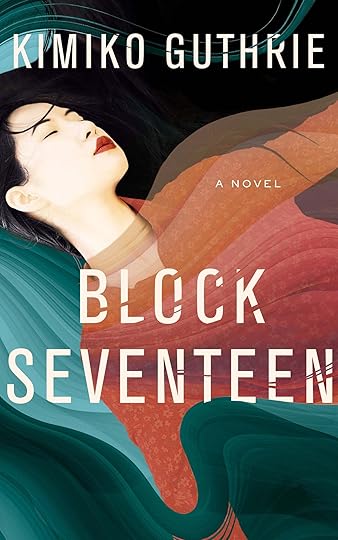
Written by Stephen Hong Sohn
Edited by Uttara Rangarajan
So, this review is going to be a very short one for Kimiko Guthrie’s Block Seventeen (Blackstone Publishing, 2020). A different student wanted to read this book with me, so I am reviewing it just to give a little bit more coverage to independent and smaller presses. Blackstone’s history, which you can find out about it by clicking on the link below and browsing around the site, is an interesting one, and I’m always impressed by the ways that independent presses manage to grow and thrive. Let’s let the official marketing description move us along: “Akiko ‘Jane’ Thompson, a half-Japanese, half-Caucasian woman in her midthirties, is attempting to forge a quietly happy life in the Bay Area with her fiancé, Shiro. But after a bizarre car accident, things begin to unravel. An intruder ransacks their apartment but takes nothing, leaving behind only cryptic traces of his or her presence. Shiro, obsessed with government surveillance, risks their security in a plot to expose the misdeeds of his employer, the TSA. Jane’s mother has seemingly disappeared, her existence only apparent online. Jane wants to ignore these worrisome disturbances until a cry from the past robs her of all peace, forcing her to uncover a long-buried family trauma. As Jane searches for her mother, she confronts her family’s fraught history in America. She learns how the incarceration of Japanese Americans fractured her family, and how persecution and fear can drive a person to commit desperate acts.”
I found this novel pretty frustrating, even though the general conceit is interesting and the political dynamics of it are quite compelling. Guthrie’s part of a really talented generation of writers mining the incarceration experience in that latent way that comes with the territory of something traumatic being repressed. In this sense, we can add this work to other fictions produced by a bevy of writers, including but in no way limited to Julie Otsuka, David Mura, and Karen Tei Yamashita, who have explored the legacy of incarceration as it moves through time and impacts successive generations. This aspect of the novel is its most important. At the same time, readers may find themselves stymied by the slow progression of Jane’s self-awareness. Indeed, at times, I felt sometimes a couple steps ahead of her and wished that she would begin to fill in the dots that Guthrie makes already quite evident via the use of italics sections that take place in the distant incarceration past. The hallmark of Toni Morrison’s Beloved is all over this text, but Guthrie is hamstrung by Jane’s general malaise, which ultimately causes the narrative to burn more slowly than it should.
Buy the Book Here
 comments
comments
A Review of Amitava Kumar’s Immigrant, Montana (Knopf, 2018)
![[personal profile]](https://i.gr-assets.com/images/S/compressed.photo.goodreads.com/hostedimages/1491408111i/22407843.png) uttararangarajan
uttararangarajan
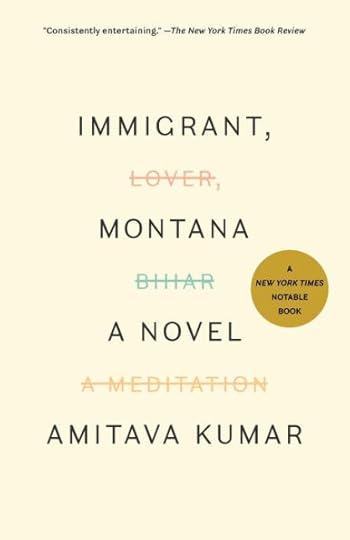
Written by Stephen Hong Sohn
Edited by Uttara Rangarajan
Ah, so I’m lucky to have some former students who like to be in sort of informal book clubs! One such engagement leads me to review Amitava Kumar’s Immigrant, Montana (Knopf, 2018). Kumar has published quite a bit, but I’m not sure I have had a chance to review his work until this one, and what a doozy. Autofiction is a complicated, complex beast. Let’s go with the marketing description at this point: “Carrying a single suitcase, Kailash arrives in post-Reagan America from India to attend graduate school. As he begins to settle into American existence, Kailash comes under the indelible influence of a charismatic professor, and also finds his life reshaped by a series of very different women with whom he recklessly falls in and out of love. Looking back on the formative period of his youth, Kailash’s wry, vivid perception of the world he is in, but never quite of, unfurls in a brilliant melding of anecdote and annotation, picture and text. Building a case for himself, both as a good man in spite of his flaws and as an American in defiance of his place of birth, Kailash weaves a story that is at its core an incandescent investigation of love—despite, beyond, and across dividing lines.”
My former student and I were initially attracted to the title since there isn’t a place called Immigrant, Montana. We did think though that Montana would feature more heavily in this novel, but it doesn’t. This novel is more of the campus genre type, with the text moving through Kailash’s experience in graduate school and the various relationships that he has with women, as he moves through his dissertation writing. Many of the chapters are structured around these relationships. In “Jennifer,” we see how Kailash ends up in what seems to be a casual relationship with a bookstore employee. The relationship eventually gets complicated when Jennifer gets pregnant. She eventually decides to get an abortion, with Kailash not fully understanding that his relative apathy toward Jennifer’s pregnancy serves to suggest that Kailash is not serious enough about their long-term potential. In “Nina,” we see Kailash’s first relationship with someone who is also in graduate school and all the complications that might arise out of that dynamic. Whereas one might have described Kailash as somewhat aloof with Jennifer, the opposite is true with Nina. Kailash struggles to figure out how serious their connection might be, and eventually it becomes apparent that Nina does not seem to be as invested in their romance as Kailash is. With “Cai,” it would seem that Kailash has finally met someone who might be the appropriate match. The problem, as we discover, is that Kailash, has been an unreliable narrator pretty much all along. Kailash, while seemingly being invested in romance, has often had dalliances on the side, and we begin to see the catastrophic emergence of this habit with the way that his connection with Cai ultimately implodes. As someone who has gone to graduate school, I found this particular novel quite difficult to get through just in terms of subject matter. Yet, Kumar finds much richness in the messiness and the sensitivity of these connections, so he makes the most of these campus dynamics. His portrayal of major professors in a given program seems to verge somewhat on hagiography, but that might seem appropriate from the purview of the ways that graduate students tend to put their mentors on pedestals. You might be wondering: what about dissertation writing? Well, Kumar knows as well as anyone else that a novel that covered the trials and tribulations of this process would not be very compelling to read as entertainment, so he generally avoids giving us too much information about this process and for that, we in the know, thank him.
Buy the Book Here
 comments
comments
A Review of Tiffany Tsao’s The Majesties (Atria, 2020)
![[personal profile]](https://i.gr-assets.com/images/S/compressed.photo.goodreads.com/hostedimages/1491408111i/22407843.png) uttararangarajan
uttararangarajan
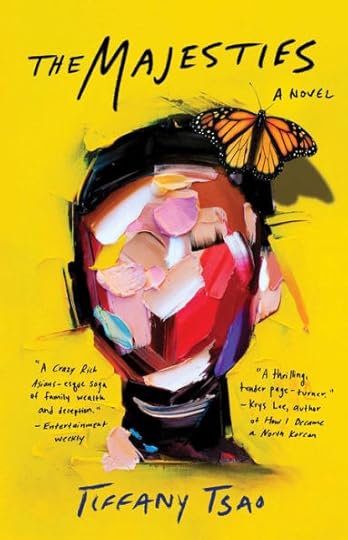
Written by Stephen Hong Sohn
Edited by Uttara Rangarajan
I seem to have slightly overdone the creative nonfiction thing because I ended up reading four fictional works in a row, and I’m in the middle of a fifth. The first I am reviewing is actually a re-read of a novel: Tiffany Tsao’s The Majesties (Atria, 2020). I read this not long after the book came out, but I realize that I never actually reviewed it, so here I am. I can’t believe how much I forgot, especially the last chapter with the major, Shyamalanesque reveal (no, she doesn’t see dead people, but there’s something like that, and I will spoil it all). Let’s let the marketing description propel us further: “Gwendolyn and Estella have always been as close as sisters can be. Growing up in a wealthy, eminent, and sometimes deceitful family, they’ve relied on each other for support and confidence. But now Gwendolyn is lying in a coma, the sole survivor of Estella’s poisoning of their whole clan. As Gwendolyn struggles to regain consciousness, she desperately retraces her memories, trying to uncover the moment that led to this shocking act. Was it their aunt’s mysterious death at sea? Estella’s unhappy marriage to a dangerously brutish man? Or were the shifting loyalties and unspoken resentments at the heart of their opulent world too much to bear? Can Gwendolyn, at last, confront the carefully buried mysteries in their family’s past and the truth about who she and her sister really are?”
This description does not provide much information about the ethnic and transnational elements of this text. Most of the story concerns the rich Sulinado family who are Chinese Indonesians. Estella and Gwendolyn seem to be close sisters, though Estella ends up marrying a man that distances her from the family at large. The marriage is still supported by the Sulinados because Estella’s husband is none other than the son of another rich family, but that family’s wealth craters. For her part, Gwendolyn ends up managing one side of the family business, which involves animated jewelry. If that phrase doesn’t make sense to you, that’s okay. Animated jewelry is exactly what it sounds like. Imagine that the necklace you’re wearing can briefly take flight and then return around your neck. That’s exactly what Gwendolyn’s business designs. To make these unique creations, Gwendolyn actually has to cultivate a kind of fungus that is known to make insects turn into zombies, as their mobile functions and actions are taken over. The whole point is that the fungus can be used to move things and thus make jewelry in new ways. Not surprisingly, the venture is a success and Gwendolyn’s business thrives. Estella is way more ambivalent about her family’s affluence and searches for an aunt who may or may not be alive. Taking Gwendolyn with her, Estella finds out where this aunt is hiding, and they discover the very complicated and tragic story that led her to break complete ties with the Sulinados. Suffice is to say that wealth brings a lot of privilege, including the possibility that the family can orchestrate the apocalyptic ending of any relationship that it does not approve of (in this respect, it does remind me of something from C. Pam Zhang’s Land of Milk and Honey). Now, to that ending (and another spoiler warning)! So, the novel is written en medias res and sort of anachronically. The last chapter gets us to the point essentially of where we started the novel, with the entire Sulinado family, sans Gwendolyn and Estella, dying What we discover is that Gwendolyn and Estella are actually*drum roll please*the same person! Yes, so we have one of those split identity stories that I’ve seen a number of times (see An Na’s The Place Between Breaths and Emiko Jean’s We’ll Never Be Apart for variations on this plot). I wasn’t entirely sold on it, but hey that’s just me! Unfortunately, when I looked up some of the links to this book, a lot of the reviews mentioned Crazy Rich Asians. This novel is definitely not that one, and I think anyone who comes into it thinking that it would be the same has not read any of the actual marketing materials. Tsao has written transnational, Asian American class satire, one that drives home the ethical quandaries that derive out of affluence.
Buy the Book Here
 comments
comments
A Review of S.L. Huang’s The Water Outlaws (Tor, 2023)
![[personal profile]](https://i.gr-assets.com/images/S/compressed.photo.goodreads.com/hostedimages/1491408111i/22407843.png) uttararangarajan
uttararangarajan
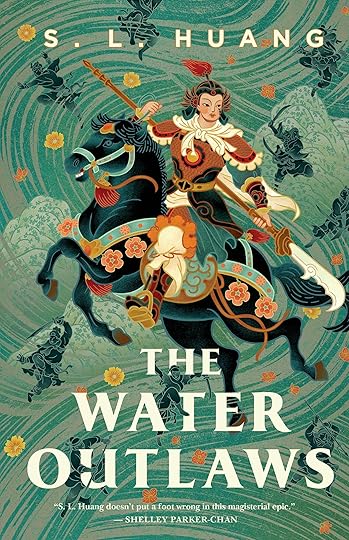
Written by Stephen Hong Sohn
Edited by Uttara Rangarajan
It’s been a little bit of time since I reviewed anything by S.L. Huang, so it was great to be able to spend the last week reading her high fantasy book The Water Outlaws (Tor, 2023), which is a retelling of the classic Chinese novel Water Margin. Some names are the same; others are changed, and Huang takes the core idea from the earlier text and then remixes it with a lot of speculative elements: “Lin Chong is an expert arms instructor, training the Emperor's soldiers in sword and truncheon, battle axe and spear, lance and crossbow. Unlike bolder friends who flirt with challenging the unequal hierarchies and values of Imperial society, she believes in keeping her head down and doing her job. Until a powerful man with a vendetta rips that carefully-built life away. Disgraced, tattooed as a criminal, and on the run from an Imperial Marshall who will stop at nothing to see her dead, Lin Chong is recruited by the Bandits of Liangshan. Mountain outlaws on the margins of society, the Liangshan Bandits proclaim a belief in justice—for women, for the downtrodden, for progressive thinkers a corrupt Empire would imprison or destroy. They’re also murderers, thieves, smugglers, and cutthroats. Apart, they love like demons and fight like tigers. Together, they could bring down an empire.”
Admittedly, I haven’t read Water Margin, so I don’t know too much about how to read this text as a kind of revision and a reimagining of it, but I did really enjoy it simply on the level of the plot. This novel does have a lot of gore, torture, and death, so the author includes a trigger warning early on, which I felt was more than fair and warranted. What was maddening about this book is the level of corruption and self-interest that motivates powerful governmental officials. The plot gets into motion because Lin Chong, a talented instructor of arms, basically refuses to be sexually assaulted by a high-level bureaucrat named Gao Qiu. Lin Chong is labeled a traitor to the empire under a false claim made by Gao Qiu, and she is originally slated to be executed. A plea by her friend Lu Junyi reduces the sentence, and she will be sent to complete hard labor in a prison camp, but what Lu Junyi doesn’t know is that Gao Qiu is already a step ahead and has planned for the guards who are escorting her to the prison camp to execute Lin Chong before she events get there. Lu Junyi had managed to send Lu Da, a lower-level military fighter to ensure that Lin Chong makes it to the prison camp, and it is Lu Da’s intervention (and the power of something called god’s teeth) that allows Lin Chong to survive that trip. Lin Chong ends up convalescing amongst the ragtag bandits of Liangshan. Back in the Empire, Cai Jiang, another high-level bureaucrat, is focusing on some experiments related to the scholar’s stone, which seems to be a kind of variation of the power that emanates from god’s teeth. Cai Jiang pushes Lu Junyi into this task, and it is Cai Jiang’s quest to harness this power that ends up the biggest source of antagonism for the Liangshan bandits. The Liangshan bandits end up getting into a tussle related to a group of soldiers that Cai Jiang needs to gain more resources, and so Cai Jiang ends up targeting them. The concluding arc sees Cai Jiang essentially use Gao Qiu as a pawn so that he can use the power of god’s teeth to destroy the Liangshan bandits. For their part, the Liangshan bandits put up a great fight, and the final sequence is impressively paced.
Buy the Book Here
 comments
comments
A Review of Mako Yoshikawa’s Secrets of the Sun (Mad Creek Books, 2024)
![[personal profile]](https://i.gr-assets.com/images/S/compressed.photo.goodreads.com/hostedimages/1491408111i/22407843.png) uttararangarajan
uttararangarajan
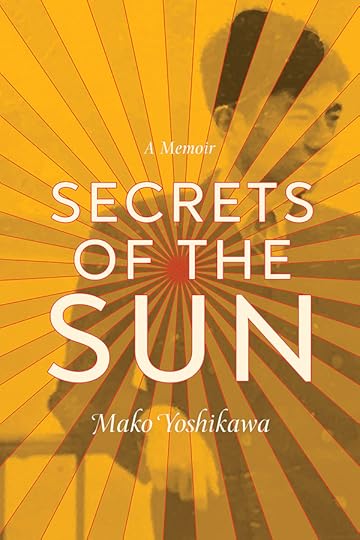
Written by Stephen Hong Sohn
Edited by Uttara Rangarajan
This one’s going to be a very short review of Mako Yoshikawa’s Secrets of the Sun. I managed to find a relatively affordable used copy of this one and wanted to give this book a shoutout. We reviewed one of Yoshikawa’s novels on AALF a long time ago, and I was really happy to see that she had published another full-length work. Let’s move to the marketing description: “Mako Yoshikawa’s father, Shoichi, was a man of contradictions. He grew up fabulously wealthy in prewar Japan but spent his final years living in squalor; he was a proper Japanese man who craved society’s approval yet cross-dressed; he was a brilliant Princeton University physicist and renowned nuclear fusion researcher, yet his career withered as his severe bipolar disorder tightened its grip. And despite his generosity and charisma, he was often violent and cruel toward those closest to him. Yoshikawa adored him, feared him, and eventually cut him out of her life, but after he died, she was driven to try to understand this extraordinarily complex man. In Secrets of the Sun, her search takes her through everything from the Asian American experience of racism to her father’s dedication to fusion energy research, from mental illness to the treatment of women in Japan, and more. Yoshikawa gradually discovers a life filled with secrets, searching until someone from her father’s past at last provides the missing piece in her knowledge: the story of his childhood. Secrets of the Sun is about a daughter’s mission to uncover her father’s secrets and to find closure in the shadow of genius, mental illness, and violence.”
I’ve slowly been making my way through a lot of Mad Creek titles, which is an imprint out of Ohio State University Press, and I’ve really loved them all. This one is no different despite being one of the most challenging, because Yoshikawa is truly working hard to find a way to understand her very difficult father who suffers from bipolar disorder. Despite the complicated feelings that Yoshikawa has for her father—and she indeed questions whether or not she has any truly deep feelings for him given their history—the extraordinary work of care is evident here, especially in the way that Yoshikawa works painstakingly to find out what might have driven her father to make some of the choices that he did. This investigative work will ultimately take her to Japan, where critical information from her father’s sister (her aunt) leads her to realize that she has not fully understood her his family background A stunning memoir that burns brightly and exposes the multifaceted contours of an Asian American family.
Buy the Book Here
 comments
comments
June 27, 2025
A Review of Y-Dang Troeung’s Landbridge (Duke UP, 2024)
![[personal profile]](https://i.gr-assets.com/images/S/compressed.photo.goodreads.com/hostedimages/1491408111i/22407843.png) uttararangarajan
uttararangarajan
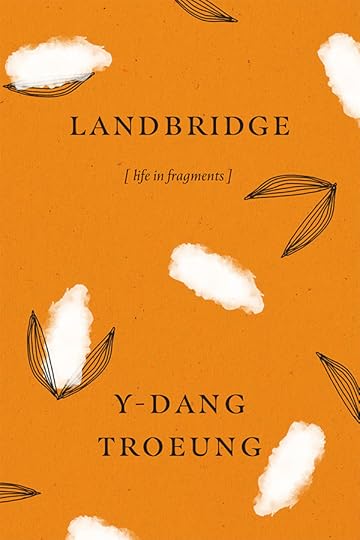
Written by Stephen Hong Sohn
Edited by Uttara Rangarajan
I knew I would eventually review Y-Dang Troeung’s Landbridge (Duke UP, 2024), but I also knew that it was going to be a challenge. Troeung is someone that I crossed paths with in practically another academic life, when I was barely out of graduate school and had the chutzpah to try to get do a bunch of editing (thinking that I would somehow manage all that and write books and articles necessary for tenure). During that period, there were some major strikes of luck. One was the opportunity to co-edit an issue of Modern Fiction Studies with the brilliant, monstrously well-read Paul Lai and then the indefatigable and generous Donald C. Goellnicht. During the editing process, Troeung’s piece on Monique Truong would come to the top of the pile, and her piece would go on to be published in the special issue on Theorizing Asian American Fiction. Goellnicht would pass away unexpectedly around 2019. Goellnicht also happened to have advised Troeung as a graduate student, and then Troeung would pass away in 2022. Fortunately for all of us, Troeung has already left an indelible legacy with an academic monograph (Refugee Lifeworlds) and this creative nonfictional work, which was published posthumously. Let’s let the marketing description do some work for us: “In 1980, Y-Dang Troeung and her family were among the last of the 60,000 refugees from Cambodia that Canada agreed to admit. Their landing was widely documented in newspapers, with photographs of the prime minister shaking Troeung’s father’s hand and patting baby Y-Dang’s head. Troeung became a literal poster child for the benevolence of the Canadian refugee project. She returns to this moment forty years later in her arresting memoir Landbridge, where she explores the tension between that public narrative of happy ‘arrival,’ and the multiple, often hidden truths of what happened to her family. In precise, beautiful prose, Troeung moves back and forth in time to tell stories about her parents and two brothers who lived through the Cambodian genocide, about the lives of her grandparents and extended family, about her own childhood in the refugee camps and in rural Ontario, and eventually about her young son’s illness and her own diagnosis with a terminal disease. Throughout this brilliant and astonishing book, Troeung looks with bracing clarity at refugee existence and dares to imagine a better future, with love.”
This creative nonfictional work is not for the faint of heart. You might have to take some space at times to read it, but I will say immediately that I’m so glad that this work is out in the world, as it adds to the growing and necessary body of Cambodian American cultural productions. There was a time that I really struggled to add Cambodian American literature to my syllabi. At one point, I felt like I basically only had the option of Loung Ung, but these days, the writers in this ethnic subset are truly growing. Landbridge is an anachronistically sequenced work, with short chapters typically around 1-3 pages in length. Troeung toggles through multiple time periods, but there are some major temporal concentration points. There’s of course the sections that deal with her parents’ time during the genocide and their lives as refugees. Then, there’s Troeung growing up in Canada. One of the best recurring motifs is the one about how the family would engage in digging up worms to make extra money. Though this type of activity might seem strange to some, for Troeung, it was always a time of family bonding and community building, and she comes to look back nostalgically on those moments, as evidence of her family’s resilience. Then, there’s the section where Troeung has traveled to Hong Kong, a time of budding romance and a time where she begins to wrestle with the ghosts of her past. The proximity she retains to Cambodia allows her to visit consistently, and she struggles with how to reframe her understanding of the country and to consider its history as one that cannot only be encapsulated by trauma and catastrophic death. Finally, there is her return to Canada and the challenges that come with tenure and then the diagnosis of cancer. Interspersed throughout the work are the most heartbreaking yet crucial sections: letters that Troeung is writing to her young child, some of which are dated into the future. Here, we see Troeung thinking proleptically, archiving this relationship so that there is a record for her child to return to again and again. Despite the gravity of the subject matter, Troeung has the prose of a poet, and the fragmented styling suits this lyric quality. This creative nonfiction of course reminds me more and more of the boundary breaking ways that scholars have been exploring their work and this text can easily be put alongside the many now emerging from academics, such as Anne Anlin Cheng’s Ordinary Disasters and Sarah Chihaya’s Bibliophobia. Let’s hope it’s part of a long and enduring trend.
Buy the Book Here
 comments
comments
A Review of Susanna Kwan’s Awake in the Floating City (Pantheon, 2025)
![[personal profile]](https://i.gr-assets.com/images/S/compressed.photo.goodreads.com/hostedimages/1491408111i/22407843.png) uttararangarajan
uttararangarajan
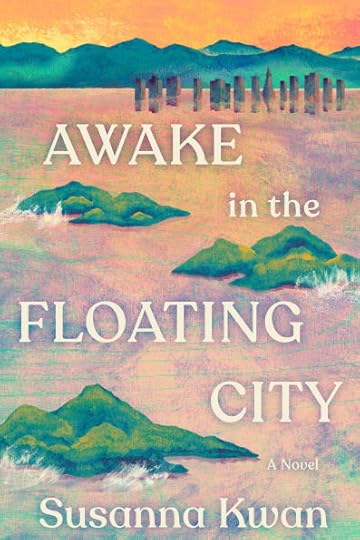
Written by Stephen Hong Sohn
Edited by Uttara Rangarajan
Ah, the call of travel is always a great occasion to bring a book onto a plan. Such was the case with Susanna Kwan’s Awake in the Floating City (Pantheon, 2025), which is an auspicious debut. The field of Asian American speculative fiction has really taken off, and this novel is evidence that this subarea is one of the most robust in the current moment. Let’s let the marketing description do some work for us: “Bo knows she should go. Years of rain have drowned the city and almost everyone else has fled. Her mother was carried away in a storm surge and ever since, Bo has been alone. She is stalled: an artist unable to make art, a daughter unable to give up the hope that her mother may still be alive. Half-heartedly, she allows her cousin to plan for her escape—but as the departure day approaches, she finds a note slipped under her door from Mia, an elderly woman who lives in her building and wants to hire Bo to be her caregiver. Suddenly, Bo has a reason to stay. Mia can be prickly, and yet still she and Bo forge a connection deeper than any Bo has had with a client. Mia shares stories of her life that pull Bo back toward art, toward the practice she thought she’d abandoned. Listening to Mia, allowing her memories to become entangled with Bo’s own, she’s struck by how much history will be lost as the city gives way to water. Then Mia’s health turns, and Bo determines to honor their disappearing world and this woman who’s brought her back to it, a project that teaches her the lessons that matter most: how to care, how to be present, how to commemorate a life and a place, soon to be lost forever.”
The novel is primarily told through Bo’s perspective. Both are Chinese American characters, which is a crucial element to this story precisely because so much Chinese American cultural history is woven in throughout. The other important element is the city of San Francisco, which emerges as a kind of third character here. I tend to think that Kwan’s novel is really a response to the COVID pandemic. Bo’s experiences being isolated in a flooded high rise seems to be something of a refraction of the experience of so many in that early lockdown period, but Kwan really takes it in a different direction with the climate fiction elements. The rains seem to be neverending and most residents of the city have taken flight, off to drier areas or at least somewhere where produce can be grown more easily. Given Bo’s status as an able-bodied individual, you might think that she would have left, but San Francisco is her home, and she just can’t quit it. When Mia reaches out with request for help (Mia is a centenarian from what I remember), Bo can’t really say no. After all, Bo has been a caregiver in the past, and she develops a soft spot for the irascible Mia. What I loved most about this novel is that it is both a plot of friendship and alternative kinship, one that rises over and above any romance element. At the same time, Kwan is really attentive to issues of archiving and grief, as she sees her city transformed into something basically unrecognizable. The novel is also a kuntslerroman. Bo sees herself as a failed artist, but connecting with Mia allows her the opportunity to rekindle her connection to her creative endeavors. As Mia’s condition begins to worsen, Bo gives herself a deadline: to try to draw up a huge archival production that is partially based upon Mia’s past. While Kwan’s work is a quiet work, one that is primarily a character study, there is a level of narrative urgency that occurs once readers discover that Bo has one clear opportunity to leave. But this leavetaking would require that Bo leave Mia in a state of debility. Bo eventually makes a cataclysmic choice, which may maroon here in San Francisco, but for Bo, who has gotten used to foraging from her own mycelial wall and who cannot seem to think of anywhere else as home, you know that she’s made the right decision. Mia dies, but not before she seeks Bo’s masterful work, one created with the help of an erstwhile romantic partner. With the power of drones and projecting technology, the city is awash in images and colors, and a past that many will understand is part of what makes San Francisco so beautiful and so melancholic. An elegant work constructed with impressive restraint.
Buy the Book Here
 comments
comments
A Review of Jen Wang’s Ash’s Cabin (First Second, 2024)
![[personal profile]](https://i.gr-assets.com/images/S/compressed.photo.goodreads.com/hostedimages/1491408111i/22407843.png) uttararangarajan
uttararangarajan
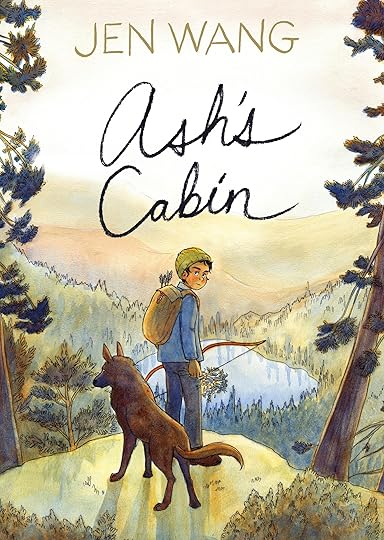
Written by Stephen Hong Sohn
Edited by Uttara Rangarajan
I’ve been meaning to pick up Jen Wang’s Ash’s Cabin (First Second, 2024) for quite some time! I have been a huge fan of Wang’s work since Koko Be Good and have read most of what has come out since then (e.g. Stargazing, The Prince and the Dressmaker). I want to start off by saying I hope I have not made any gendering errors here, as I sometimes automatically revert to a gendered pronoun due to grammatical misfiring in my brain, so please give me some grace! In any case, Ash’s Cabin was the perfect book for me to read at the time. I remember that as I moved further into it, all I could think about was My Side of the Mountain and Hatchet, two books that I loved as a kid. Lo and behold, these two books are cited in a “for further reading” section by Wang, so we obviously read the same things as a kid. Let’s move to that ever-crucial marketing description: “Ash has always felt alone. Adults ignore the climate crisis. Other kids Ash’s age are more interested in pop stars and popularity contests than in fighting for change. Even Ash’s family seems to be sleepwalking through life. The only person who ever seemed to get Ash was their Grandpa Edwin. Before he died, he used to talk about building a secret cabin, deep in the California wilderness. Did he ever build it? What if it’s still there, waiting for him to come back…or for Ash to find it? To Ash, that maybe-mythical cabin is starting to feel like the perfect place for a fresh start and an escape from the miserable feeling of alienation that haunts their daily life. But making the wilds your home isn’t easy. And as much as Ash wants to be alone…can they really be happy alone? Can they survive alone?”
So, Ash ends up deciding to find out if Grandpa Edwin’s secret cabin ever existed, but they have to come up with a plan to get their way up to the area. Fortunately, Ash pushes against their parent’s wishes for vacation plans and instead is allowed to go up to some relatives in that area. Once Ash finds the perfect way to go exploring (which ends up of course creating drama down the line), they go deep into the wilderness with his trusty dog Chase. They eventually find the cabin, but living on one’s own is harder than Ash realizes. All the books they’ve read do not necessarily translate to skills out in the wild. After Ash poisons themself, they have to get help, and Ash eventually finds someone who is also finding their own way. They strike a brief friendship, and this new friend helps Ash refurbish their grandfather’s cabin. Of course, I completely forgot to mention that Ash is ¼ Chinese, as their grandfather was Chinese American! In any case, the friend goes on their way, while Ash continues to live the good life up at the cabin. When a bear attack injures Chase, Ash must make some difficult decisions about what they want to do. After all, by that point, Ash’s family has sent many people out to look for them, and Ash has been avoiding the helicopters that they see overhead. Ash ultimately realizes that they must go back to civilization and give Chase the car that the dog needs. Once back home, Ash begins to discover that they can find their way through a world that is increasingly being sensitive to their pronouns and their journey. In this respect, Ash’s story is one that will resonate with many readers, who to find a path and a life in which their gender is theirs to claim. What I especially appreciated about Wang’s political approach to this trans storyline is that Wang refuses to allow anyone to misgender Ash through deadnaming. Any time Ash’s deadname is used it is blocked out, so we already see how the graphic perspective can enact a form of representational justice. In this era of anti-DEI and book banning, I am worried that a Wang’s graphic novel may not find its readers, but I am so happy that this book is out into the world, especially in this moment and in this time of political violence. These are the kinds of books that can absolutely save lives. At the same time, Wang’s art and story are always first rate, and we should feel lucky that we are in a moment that we can see such brilliant work being produced and shared.
Buy the Book Here
 comments
comments
A Review of Tasha Suri’s Jasmine Throne (Orbit, 2021)
![[personal profile]](https://i.gr-assets.com/images/S/compressed.photo.goodreads.com/hostedimages/1491408111i/22407843.png) uttararangarajan
uttararangarajan
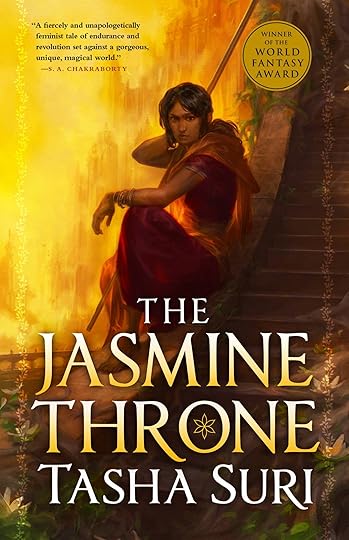
Written by Stephen Hong Sohn
Edited by Uttara Rangarajan
Tasha Suri’s Burning Kingdoms trilogy is completed, so I’m now starting with the first: Jasmine Throne (Orbit, 2021). This first installment is clearly one of those Asian-inspired high fantasies. I wonder sometimes about the need to code Asian-ness so specifically in these texts in the first place, but I digress (for now). Let’s let the pithy marketing description give us some more information: “Exiled by her despotic brother, princess Malini spends her days dreaming of vengeance while imprisoned in the Hirana: an ancient cliffside temple that was once the revered source of the magical deathless waters but is now little more than a decaying ruin. The secrets of the Hirana call to Priya. But in order to keep the truth of her past safely hidden, she works as a servant in the loathed regent’s household and cleaning Malini’s chambers. When Malini witnesses Priya’s true nature, their destinies become irrevocably tangled. One is a ruthless princess seeking to steal a throne. The other a powerful priestess desperate to save her family. Together, they will set an empire ablaze.”
This description really doesn’t do enough to outline the variety of major characters that you’ll see throughout the text. From what I recall—and pardon my hazy memory, as I finished this one using a mix of audiobook and print editions, and I completed this one over a good month—there are at least three or four other major characters, including Bhumika, someone with powers much like Priya, and then Ashok, who is Priya’s brother and part of the revolutionary movement to depose the current power structure. The novel starts out a bit slow, but Suri is giving us time to get into the world-building. This world is one in which magic is somewhat hidden, and Priya seems to have some powers related to nature, which are connected to the Hirana. The deathless waters are the places where temple-goers used to be able to bathe into and, if they survived, they were given increasing level of magic ability. As I understand it, figures can be bathed up to three times, and the thrice-born, as they are named, are the most powerful of them all. What the synopsis doesn’t really outline is there is a queer romantic subtext between Malini and Priya that is all the more complicated by each other’s station. Malini realizes that Priya would be a powerful ally, given her magical abilities, while Priya begins to understand that, should Malini be able to find a way out of the Hirana, Malini might be a better ruler than the current one and give everyone a better chance at flourishing. But there are tons of obstacles. Needless to say, the novel sets up the chess pieces to let us know that an even larger battle is brewing. Though Priya and Malini go their separate ways by the ending of the novel, we know that each is well-positioned to make the kingdom a better place. I appreciated most Suri’s attentiveness to character development, which makes the novel move much faster at the later stages, given your investments in each character. A good example is even a minor figure like Rukh, a character who infested with the rot, and who is introduced very early on in the novel. He seeks out Priya for her aid. You are inclined to hope that there will be a way to save him, even as it is clear he might have multiple intentions for gaining Priya’s favor. By the end, Rukh’s arc is particularly well-earned and poignant, and Suri thus always leaves a very satisfying element to the stories, even as the larger battles of power remain unclosed. Very much looking forward to the second in this series!
Buy the Book Here
 comments
comments



